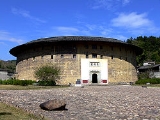
Fujian Tulou
Encyclopedia
Fujian Tulou is a type of Chinese rural dwellings of the Hakka
and others in the mountainous areas in southeastern Fujian
, China. They were mostly built between the 12th and the 20th centuries.
A tulou is usually a large, enclosed and fortified earth building, rectangular or circular in configuration, with very thick load-bearing rammed earth
walls between three and five stories high and housing up to 80 families. Smaller interior buildings are often enclosed by these huge peripheral walls which can contain halls, storehouses, wells and living areas, the whole structure resembling a small fortified city.
The fortified outer structures are formed by compacting earth, mixed with stone, bamboo, wood and other readily available materials, to form walls up to 6 feet (1.8 m) thick. Branches, strips of wood and bamboo chips are often laid in the wall as additional reinforcement. The end result is a well-lit, well-ventilated, windproof and earthquake-proof building that is warm in winter and cool in summer. Tulous usually have only one main gate, guarded by 4–5 in (101.6–127 mm) wooden doors reinforced with an outer shell of iron plate. The top level of these earth buildings has gun holes for defensive purposes.
A total of 46 Fujian Tulou sites, including Chuxi tulou cluster, Tianluokeng tulou cluster
, Hekeng tulou cluster, Gaobei tulou cluster, Dadi tulou cluster, Hongkeng tulou cluster, Yangxian lou, Huiyuan lou, Zhengfu lou and Hegui lou, have been inscribed in 2008 by UNESCO
as World Heritage Site
, as "exceptional examples of a building tradition and function exemplifying a particular type of communal living and defensive organization[in a] harmonious relationship with their environment".
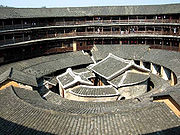 Since the 1980s, the Fujian Tulou has been variously called "Hakka tulou", "earth dwelling", "round stronghouse" or simply "tulou". Tu lou (土樓) literally translates as earthen structures. Whereas Fujian Tulous's literal translation is "Fujian earthen structures", and scholars of Chinese architecture have recently standardized the term Fujian Tulou, it would be incorrect to assume that all tulou-dwellers were Hakka people; large numbers of southern Fujian people have also historically lived in tulous.
Since the 1980s, the Fujian Tulou has been variously called "Hakka tulou", "earth dwelling", "round stronghouse" or simply "tulou". Tu lou (土樓) literally translates as earthen structures. Whereas Fujian Tulous's literal translation is "Fujian earthen structures", and scholars of Chinese architecture have recently standardized the term Fujian Tulou, it would be incorrect to assume that all tulou-dwellers were Hakka people; large numbers of southern Fujian people have also historically lived in tulous.
Parts of Hakka tulou belong to the Fujian Tulou category. While all south Fujian tulous belong to the Fujian Tulou category, they do not belong to "Hakka Tulou". In effect, "Fujian Tulou" is not a synonym for "tulou", but rather a special subgroup of the latter. There are more than 20,000 tulous in Fujian, while there are only around three thousand "Fujian Tulou" located in southwestern region of Fujian province, mostly in the mountainous regions of Yongding County of Longyan
City and Nanjing County
of Zhangzhou
City. Fujian Tulou is however the official name adopted by UNESCO for all dwellings of this type.
The Fujian Tulou is defined as: "A large multi storey building in southeast Fujian mountainous region for large community living and defense, built with weight bearing rammed earth wall and wood frame structure."

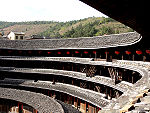 Chuxi Tulou cluster 初溪土樓群, located as Yongding County Xiayang township Chuxi village. Inscribed as UNESCO World Heritage site 1113-001.
Chuxi Tulou cluster 初溪土樓群, located as Yongding County Xiayang township Chuxi village. Inscribed as UNESCO World Heritage site 1113-001.
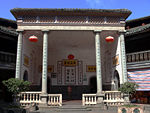 Zhenchenglou 振成樓, nicknamed "the prince of tulou", belongs to Hongkeng Tulou cluster. It is located in Hongkeng village, Hukeng township of Yongding County. Inscribed as UNESCO World Heritage 1113-002 It was built in 1912 by the descendents of a rich tobacco merchant. Zhenchenglou is a double ring tulou, its outer ring is four storeys high, total 184 rooms, the inner ring is two storeys with 32 rooms. The outer ring was partitioned into four segments according to Bagua concept
Zhenchenglou 振成樓, nicknamed "the prince of tulou", belongs to Hongkeng Tulou cluster. It is located in Hongkeng village, Hukeng township of Yongding County. Inscribed as UNESCO World Heritage 1113-002 It was built in 1912 by the descendents of a rich tobacco merchant. Zhenchenglou is a double ring tulou, its outer ring is four storeys high, total 184 rooms, the inner ring is two storeys with 32 rooms. The outer ring was partitioned into four segments according to Bagua concept
of Chinese Fengshui.
Western influence is evident in the Greek style columns of the ancestral hall, and in the wrought iron railing of the second level corridor.
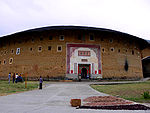
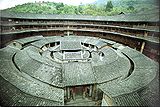 Chengqilou 承啟樓 nicknamed "the king of tulou", of Gaobei Tulou cluster 高北土樓群 at Gaotou village of Yongding County was built in 1709. Inscribed as UNESCO World Heritage Site 1113-003 in 2008. It is massive rotunda tulou with four concentric rings surrounding an ancestral hall at the center, the outer ring is 62.6 metres in diameter and four storeys tall, 288 rooms, with 72 rooms on each level, circular corridor on 2nd to 4th floor, with four sets of staircases at cardinal points connecting ground to top floors. A big roof extending out ward covers the main ring. The ground floor rooms are kitchens for family branches, the second level rooms are grain storage rooms, and the 3rd and 4th floor rooms are living quarters and bedrooms. The second ring of 80 rooms is two storeys high, with 40 rooms on each level, the third ring served as community library, one storey with 32 rooms; there are 370 rooms in all. The 4th ring is a circular covered corridor surrounding the ancestral hall. If a person stayed for one night in each room, it would take him more than a year to go through all the rooms. The ancestral hall is at the centre. Chengqilou has two main gates and two side gates. 15th generation Jiang clan with 57 families and 300 people live here. At its heyday, there were more than 80 family branches lived in Chengqilou.
Chengqilou 承啟樓 nicknamed "the king of tulou", of Gaobei Tulou cluster 高北土樓群 at Gaotou village of Yongding County was built in 1709. Inscribed as UNESCO World Heritage Site 1113-003 in 2008. It is massive rotunda tulou with four concentric rings surrounding an ancestral hall at the center, the outer ring is 62.6 metres in diameter and four storeys tall, 288 rooms, with 72 rooms on each level, circular corridor on 2nd to 4th floor, with four sets of staircases at cardinal points connecting ground to top floors. A big roof extending out ward covers the main ring. The ground floor rooms are kitchens for family branches, the second level rooms are grain storage rooms, and the 3rd and 4th floor rooms are living quarters and bedrooms. The second ring of 80 rooms is two storeys high, with 40 rooms on each level, the third ring served as community library, one storey with 32 rooms; there are 370 rooms in all. The 4th ring is a circular covered corridor surrounding the ancestral hall. If a person stayed for one night in each room, it would take him more than a year to go through all the rooms. The ancestral hall is at the centre. Chengqilou has two main gates and two side gates. 15th generation Jiang clan with 57 families and 300 people live here. At its heyday, there were more than 80 family branches lived in Chengqilou.
Other buildings in this cluster include: a three ring Shenyuanlou, outer ring 70m diameter; a Wujiaolou (pentagon) with irregular pentagonal floor plan and a rectangular tulou, the Shi-Ze lou
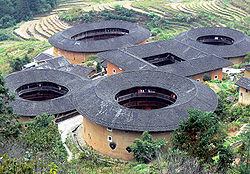
 Tianluokeng Tulou cluster
Tianluokeng Tulou cluster
田螺坑土楼群is tulou quintet cluster located at Fujian province, Zhangzhou City, Nanjing County, Shuyang Township, Tian Luo Keng Village (literally "Snail Pit" Village) in southern China, about four hours drive by motor coach or taxi from Xiamen, through winding and bumpy narrow mountain roads. It consists of five tulous with a square "Buyunlou" at the center, surrounded by three rotunda tulous and an oval tulou, forming a pattern of "four dishes and a soup" (四菜一湯). The five earth buildings at the Snail Pit village are:
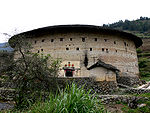
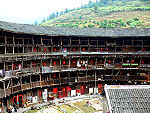 Yuchanglou 裕昌樓 is a five-storey tulou located at Nangjing county Shuyang district Xiabanliao village. It was built in 1308 Yuan dynasty
Yuchanglou 裕昌樓 is a five-storey tulou located at Nangjing county Shuyang district Xiabanliao village. It was built in 1308 Yuan dynasty
by the Liu family clan. It is one of the oldest and tallest tulou in China. Yuchanglou has been nicknamed the "zigzag building", because the vertical wooden post structure is not straight and perpendicular, but zigzags left and right. It was built that way due to an error measuring the building materials. But in spite of this apparent infirmity, this tall tulou withstood 700 hundred years of natural elements and social turmoil. Yuchanglou's outer ring is 36 m in diameter and boasts five storeys, with 50 rooms on each floor.
Each of the 25 kitchens on the ground floor at the back half of the circle has a private water well beside its stove. This is the only tulou in all Fujian with such convenient water supply.
There was a one storey inner-ring house surrounding the ancestral hall as late as 2003. This part of the building stood nearly 700 years intact until, unfortunately, it was dismantled after 2003
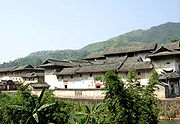
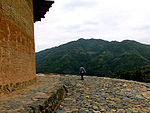
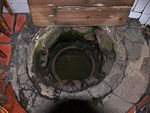

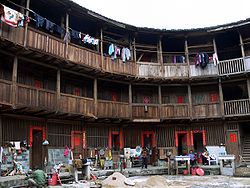 The layout of Fujian tulou followed the Chinese dwelling tradition of "closed outside, open inside" concept: an enclosure wall with living quarters around the peripheral and a common courtyard at the centre. A small building at the center with open front served as an ancestral
The layout of Fujian tulou followed the Chinese dwelling tradition of "closed outside, open inside" concept: an enclosure wall with living quarters around the peripheral and a common courtyard at the centre. A small building at the center with open front served as an ancestral
hall for ancestry worshipping, festivals, meetings, weddings, funerals and other ceremonial functions. Ground floor plan includes circle, semicircle, oval, square, rectangle, and irregular pentagon.
The foundation of tulou building was built with paved stones on top of compacted earth ground, in two to three tiers. There is a circular drain around the top tier foundation to prevent rainwater from damaging the tulou wall.
In most cases, the weight bearing outer wall of tulou consists of two sections, the lower section is built from cut stone blocks or river cobbles held together with a lime, sand and clay mixture to a height of about one or two metres, depend upon the regional flood water level. The compacted earth wall stacked on top of the stone section. The construction of earth wall from compacted earth mixed with sticky rice and reinforced with horizontal bamboo sticks was described first in Song dynasty
building standard the Yingzao Fashi
.
The walls were built inclined toward the centre, such that the natural force of gravity pushes the wall together. This inward inclination method was also used in the construction of Pagoda of Fogong Temple
. The thickness of the Tulou wall decreases with height as specified in Yingzao Fashi. The bottom two storeys of tulou are solid with no window nor gun hole, windows are open only from the third to fifth storeys, because rooms at the bottom storey served as family storage rooms and the upper storeys were living quarters.
The rooftops were covered with baked clay tiles, arranged radially;λ insertion technique was used at regular intervals to compensate for larger circumference at the outside.( Majority of roof tiles were laid from top to bottom, the gap caused by radial layout was compensated by
small sections of tiles laid in λ shape inserts). This technique allowed the tiles to be laid radially without visible gaps, and without the use of small tiles at top, larger tiles at bottom.
The eaves usually extend about two metres, protecting the earth wall from damage by rainwater pouring from the eaves.
The wooden frame supporting the rooftop had no dougong
elements common in traditional Chinese building.
Circular corridors from 2nd to uppermost level were made of wood boards laid on horizontal wooden beams with one end inserted into the earth wall. The corridors are protected with a circle of wooden railings.
Stairwells are distributed evenly around the corridors, four sets of stairwells being the usual number. Each stairwell leads from ground floor to the highest floor.
Public water wells in groups of two or three are usually located at the centre court; more luxurious tulou has in-house water well for each household in ground floor kitchen.
Tulous were usually occupied by one large family clan of several generations; some larger tulou had more than one family clan. Besides the building itself, many facilities such as water wells, ceremonial hall, bathrooms, wash rooms, and weaponry were shared property. Even the surrounding land and farmland, fruit trees etc. were shared. The residents of tulou farmed communally. This continued into the 1960s even during the people's commune period; at that time a tulou was often occupied by one commune production team. Each small family has its own private property, and every family branch enjoys its privacy behind closed doors.
In the old days, the allotment of housing was based on family male branch; each son was counted as one branch. Public duties such as organization of festivals, cleaning of public areas, opening and closing of the main gate, etc., was also assigned to a family branch on a rotational basis.
All branches of a family clan shared a single roof, symbolizing unity and protection under a clan; all the family houses face the central ancestral hall, symbolizing worship of ancestry and solidarity of the clan. When a clan grew, the housing expanded radially by adding another outer concentric ring, or by building another tulou close by, in a cluster. Thus, a clan stayed together.
Nowadays newer housing with modern facilities is popping up in rural China. Many residents have bought more modern houses and moved out, or live in a larger town or city for better jobs. However they keep their ancestral tulou apartment homes under padlock, only returning home during festival for family reunion.

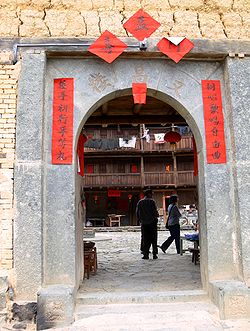
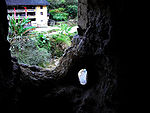
 From the 12th century to 19th century, armed bandits plagued southern China. The people of southern Fujian first built strongholds on top of mountains as a defence. These early strongholds later evolved into Fujian Tulou.
From the 12th century to 19th century, armed bandits plagued southern China. The people of southern Fujian first built strongholds on top of mountains as a defence. These early strongholds later evolved into Fujian Tulou.
The thick (two metres at bottom, tapered to one metre on top) outer walls of tulous were immune to arrows and gunfire. The lower one- to two-metre section of the outer wall was sometimes built with granite blocks or large river cobbles. This granite or cobble section was immune to digging, since the outer layer of cobbles was purposely laid with the smaller ends pointing outwards—it would be futile for any attacker to dig out such cobbles. Digging a tunnel under the wall was not possible either, because the cobble section wall was extended deep down more than one metre.
The earth wall section was built with rammed earth together with lime-sand-clay mixture and reinforced with horizontal bamboo strips for lateral binding. It was solid as a castle, immune even to cannon fire. In 1934, a group of uprising peasants of Yongding County occupied a tulou to resist the assault of the army, which fired 19 cannon shots at that tulou, but made only a small dent on the outside wall.
The weak link in a walled system was usually the gate. But the gate of Fujian tulou was specially designed for defence. The door frame was built from a large solid block of granite; the double doors were built with fire-resistant solid wood boards up to 13 cm thick, reinforced with thick iron armour plates. The main gate door was barred with several horizontal and vertical strong wood posts inserted into holes in the granite. To guard against an enemy destroying the front doors with fire, some doors were equipped with water tanks on top to quench fires set by the enemy.
Fujian Tulou residents used firearms for active defense, shooting at enemies from gun ports at the top level of the building. Some Fujian tulou are constructed with a circular corridor along the inside
wall to facilitate the movement of armed men and ammunition.
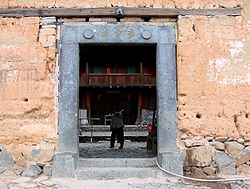 The term "tulou" first appeared in a 1573 Zhangzhou county record of the Ming dynasty; it was on record that due to the growth of bandits, many villagers built walled strongholds and tulous as a means of defence. Many families banded together in a stronghold, and several strongholds or tulous joined hand in hand with sentinels constantly on guard and lookout; loud drums and gongs were sounded as an alarm signal for any sign of approaching bandits or invaders. Due to the massive solidarity of tulou residents, even large powerful bandit gangs with tens of thousands of men dared not attack the inhabitants of tulou.
The term "tulou" first appeared in a 1573 Zhangzhou county record of the Ming dynasty; it was on record that due to the growth of bandits, many villagers built walled strongholds and tulous as a means of defence. Many families banded together in a stronghold, and several strongholds or tulous joined hand in hand with sentinels constantly on guard and lookout; loud drums and gongs were sounded as an alarm signal for any sign of approaching bandits or invaders. Due to the massive solidarity of tulou residents, even large powerful bandit gangs with tens of thousands of men dared not attack the inhabitants of tulou.
The term "tulou" also came out occasionally in some poems; other than that, the existence of tulou bypassed mainstream literature, and was not mentioned in literature published before 1956 dedicated to the study of the people's habitat.
In 1956 professor Liu Guo-zhen was the first scholar to carry out research on Fujian Tulou,
his article Hakka dwellings in Yongding County of Fujian Province was published in
The Journal of Nanjing Polytech Institute.
In 1980 Chengqi tulou appeared in a book titled History of Ancient Chinese Architecture. From then on, streams of scholars from mainland China, Taiwan, Japan, Europe and America came to Fujian Zhangzhou and Yongding to explore and study tulou; tulou has walked out from seclusion into the world stage. In particular Chinese scholar Huang Han-min (now the head of Fujian Architecture Design Institute) has spent more than twenty years on research of Fujian Tulou; his master degree thesis The Tradition Characteristics and Regional Style of Fujian Civilian Residence was completed in 1982 and published on the Chinese magazine Architect. Japanese scholar published a report Study on Chinese Civilian Housing—The Square Tulou and Round Tulou followed by photo exhibition in Japan and a book in 1989. In 1997, Dutch architect Herman Hertzberger
inspected Fujian Tulou, and in 1999 Dr. Neville Agnew of the Getty Conservation Institute
inspected Tianluokeng, Yuchanglou and Heguilou.
The book Fujian Tulou by Huang Han-min published in Taiwan in 1994, revised and republished in China in 2003 is at present one of the more authentic studies on Fujian Tulou, covering the history of tulou, its characteristics and style, its geographic distribution, folklore about tulou etc., with hundreds of color plates and drawing. English literature on this topic is still absent.
The tulous in Nanjing County are connected to the town of Nanjing by winding mountain roads. The town of Nanjing can be easily reached from the Zhanglong highway that connects Zhangzhou City with Longyan City. The Zhanglong highway is connecting the region to the rest of the Chinese network of highways. It takes approximately 2 hours by car from Xiamen
to Nanjing town.
There are commuter buses from Xiamen
and Fuzhou
cities to Longyan or Zhangzhou, about 4 hours drive each way.
Hakka people
The Hakka , sometimes Hakka Han, are Han Chinese who speak the Hakka language and have links to the provincial areas of Guangdong, Jiangxi, Guangxi, Sichuan, Hunan and Fujian in China....
and others in the mountainous areas in southeastern Fujian
Fujian
' , formerly romanised as Fukien or Huguing or Foukien, is a province on the southeast coast of mainland China. Fujian is bordered by Zhejiang to the north, Jiangxi to the west, and Guangdong to the south. Taiwan lies to the east, across the Taiwan Strait...
, China. They were mostly built between the 12th and the 20th centuries.
A tulou is usually a large, enclosed and fortified earth building, rectangular or circular in configuration, with very thick load-bearing rammed earth
Rammed earth
Rammed earth, also known as taipa , tapial , and pisé , is a technique for building walls using the raw materials of earth, chalk, lime and gravel. It is an ancient building method that has seen a revival in recent years as people seek more sustainable building materials and natural building methods...
walls between three and five stories high and housing up to 80 families. Smaller interior buildings are often enclosed by these huge peripheral walls which can contain halls, storehouses, wells and living areas, the whole structure resembling a small fortified city.
The fortified outer structures are formed by compacting earth, mixed with stone, bamboo, wood and other readily available materials, to form walls up to 6 feet (1.8 m) thick. Branches, strips of wood and bamboo chips are often laid in the wall as additional reinforcement. The end result is a well-lit, well-ventilated, windproof and earthquake-proof building that is warm in winter and cool in summer. Tulous usually have only one main gate, guarded by 4–5 in (101.6–127 mm) wooden doors reinforced with an outer shell of iron plate. The top level of these earth buildings has gun holes for defensive purposes.
A total of 46 Fujian Tulou sites, including Chuxi tulou cluster, Tianluokeng tulou cluster
Tianluokeng Tulou cluster
Tianluokeng tulou cluster is one of the better known Fujian Tulou cluster. It is located in Fujian province, Zhangzhou City, Nanjing County, Shuyang Township, Tian Luo Keng Village in southern China....
, Hekeng tulou cluster, Gaobei tulou cluster, Dadi tulou cluster, Hongkeng tulou cluster, Yangxian lou, Huiyuan lou, Zhengfu lou and Hegui lou, have been inscribed in 2008 by UNESCO
UNESCO
The United Nations Educational, Scientific and Cultural Organization is a specialized agency of the United Nations...
as World Heritage Site
World Heritage Site
A UNESCO World Heritage Site is a place that is listed by the UNESCO as of special cultural or physical significance...
, as "exceptional examples of a building tradition and function exemplifying a particular type of communal living and defensive organization
Terminology

Parts of Hakka tulou belong to the Fujian Tulou category. While all south Fujian tulous belong to the Fujian Tulou category, they do not belong to "Hakka Tulou". In effect, "Fujian Tulou" is not a synonym for "tulou", but rather a special subgroup of the latter. There are more than 20,000 tulous in Fujian, while there are only around three thousand "Fujian Tulou" located in southwestern region of Fujian province, mostly in the mountainous regions of Yongding County of Longyan
Longyan
Longyan is a prefecture-level city in southwestern Fujian province, China.-Geography:It is situated in the upper reaches of the Jiulong and Tingjiang rivers...
City and Nanjing County
Nanjing County
Nanjing County is a county under the administration under of Zhangzhou prefecture-level city of Fujian province, in China....
of Zhangzhou
Zhangzhou
Zhangzhou is a prefecture-level city in southern Fujian province, People's Republic of China. Located on the banks of the Jiulong River , Zhangzhou borders the cities of Xiamen and Quanzhou to the northeast, Longyan City to the northwest and the province of Guangdong to the southwest.Zhangzhou...
City. Fujian Tulou is however the official name adopted by UNESCO for all dwellings of this type.
The Fujian Tulou is defined as: "A large multi storey building in southeast Fujian mountainous region for large community living and defense, built with weight bearing rammed earth wall and wood frame structure."
Chuxi Tulou cluster


- Jiqinglou, the largest rotunda tulou also the oldest in this cluster, built in 1419 during the reign of Emperor Yongle Ming dynastyMing DynastyThe Ming Dynasty, also Empire of the Great Ming, was the ruling dynasty of China from 1368 to 1644, following the collapse of the Mongol-led Yuan Dynasty. The Ming, "one of the greatest eras of orderly government and social stability in human history", was the last dynasty in China ruled by ethnic...
. It consists two concentric rings, the outer ring building is four storeys tall, with 53 rooms on each level. The outer ring has 72 staircases. The second ring is a one-storey building.
Zhencheng lou

Bagua (concept)
The bagua are eight diagrams used in Taoist cosmology to represent the fundamental principles of reality, seen as a range of eight interrelated concepts. Each consists of three lines, each line either "broken" or "unbroken," representing yin or yang, respectively...
of Chinese Fengshui.
Western influence is evident in the Greek style columns of the ancestral hall, and in the wrought iron railing of the second level corridor.
Chengqi lou


Other buildings in this cluster include: a three ring Shenyuanlou, outer ring 70m diameter; a Wujiaolou (pentagon) with irregular pentagonal floor plan and a rectangular tulou, the Shi-Ze lou
Tianluokeng Tulou cluster


Tianluokeng Tulou cluster
Tianluokeng tulou cluster is one of the better known Fujian Tulou cluster. It is located in Fujian province, Zhangzhou City, Nanjing County, Shuyang Township, Tian Luo Keng Village in southern China....
田螺坑土楼群is tulou quintet cluster located at Fujian province, Zhangzhou City, Nanjing County, Shuyang Township, Tian Luo Keng Village (literally "Snail Pit" Village) in southern China, about four hours drive by motor coach or taxi from Xiamen, through winding and bumpy narrow mountain roads. It consists of five tulous with a square "Buyunlou" at the center, surrounded by three rotunda tulous and an oval tulou, forming a pattern of "four dishes and a soup" (四菜一湯). The five earth buildings at the Snail Pit village are:
- The square Buyunlou (Reaching the Cloud building) at the center of the quincunx. It was the first tulou at this site, built in 1796. It is three storeys high, each storey has 26 rooms, four sets of stairs, and a go around corridor in front of the rooms at each level. The Buyun building was burnt down by bandits in 1936, rebuilt in 1953 according to the original plan.
- The Hechang building, a three-storey-high round earth building,
- Zhenchang building, three storeys, round shape, 26 rooms per storey, built in 1930
- Ruiyun building, built in 1936, three storeys, 26 rooms per floor.
- The oval shape Wenchang building of 1966, three storeys, 32 rooms per floor.
Yuchang lou


Yuan Dynasty
The Yuan Dynasty , or Great Yuan Empire was a ruling dynasty founded by the Mongol leader Kublai Khan, who ruled most of present-day China, all of modern Mongolia and its surrounding areas, lasting officially from 1271 to 1368. It is considered both as a division of the Mongol Empire and as an...
by the Liu family clan. It is one of the oldest and tallest tulou in China. Yuchanglou has been nicknamed the "zigzag building", because the vertical wooden post structure is not straight and perpendicular, but zigzags left and right. It was built that way due to an error measuring the building materials. But in spite of this apparent infirmity, this tall tulou withstood 700 hundred years of natural elements and social turmoil. Yuchanglou's outer ring is 36 m in diameter and boasts five storeys, with 50 rooms on each floor.
Each of the 25 kitchens on the ground floor at the back half of the circle has a private water well beside its stove. This is the only tulou in all Fujian with such convenient water supply.
There was a one storey inner-ring house surrounding the ancestral hall as late as 2003. This part of the building stood nearly 700 years intact until, unfortunately, it was dismantled after 2003
Eryilou
Eryilou 二宜樓 of Dadi Tulou cluster is located at Zhangzhou City Hua-an County Xiandu township Dadi Village. Built in 1770 it consists of a four-storey outer ring and a one-storey inner ring. The outer ring is 71 metres in diameter, with 48 rooms on each level. Eryilou has no circular corridor at the front of each upper level, instead it has a back corridor adjacent to the wall. The outer ring rooms are partitioned vertically into separate households, each household partition has its own set of staircases not share by other families; some partition has a frontal width of 3 rooms, others has width of 4 rooms. The partition of the inner ring is attached to the partition of the main ring via covered verandah as antechamber.Architecture





hall for ancestry worshipping, festivals, meetings, weddings, funerals and other ceremonial functions. Ground floor plan includes circle, semicircle, oval, square, rectangle, and irregular pentagon.
The foundation of tulou building was built with paved stones on top of compacted earth ground, in two to three tiers. There is a circular drain around the top tier foundation to prevent rainwater from damaging the tulou wall.
In most cases, the weight bearing outer wall of tulou consists of two sections, the lower section is built from cut stone blocks or river cobbles held together with a lime, sand and clay mixture to a height of about one or two metres, depend upon the regional flood water level. The compacted earth wall stacked on top of the stone section. The construction of earth wall from compacted earth mixed with sticky rice and reinforced with horizontal bamboo sticks was described first in Song dynasty
Song Dynasty
The Song Dynasty was a ruling dynasty in China between 960 and 1279; it succeeded the Five Dynasties and Ten Kingdoms Period, and was followed by the Yuan Dynasty. It was the first government in world history to issue banknotes or paper money, and the first Chinese government to establish a...
building standard the Yingzao Fashi
Yingzao Fashi
The Yingzao Fashi is a technical treatise on architecture and craftsmanship written by the Chinese author Li Jie , the Directorate of Buildings and Construction during the mid Song Dynasty of China. A promising architect, he revised many older treatises on architecture from 1097 to 1100...
.
The walls were built inclined toward the centre, such that the natural force of gravity pushes the wall together. This inward inclination method was also used in the construction of Pagoda of Fogong Temple
Pagoda of Fogong Temple
The Sakyamuni Pagoda of Fogong Temple of Ying County, Shanxi province, China, is a wooden Chinese pagoda built in 1056, during the Khitan-led Liao Dynasty. The pagoda was built by Emperor Daozong of Liao at the site of his grandmother's family home...
. The thickness of the Tulou wall decreases with height as specified in Yingzao Fashi. The bottom two storeys of tulou are solid with no window nor gun hole, windows are open only from the third to fifth storeys, because rooms at the bottom storey served as family storage rooms and the upper storeys were living quarters.
The rooftops were covered with baked clay tiles, arranged radially;λ insertion technique was used at regular intervals to compensate for larger circumference at the outside.( Majority of roof tiles were laid from top to bottom, the gap caused by radial layout was compensated by
small sections of tiles laid in λ shape inserts). This technique allowed the tiles to be laid radially without visible gaps, and without the use of small tiles at top, larger tiles at bottom.
The eaves usually extend about two metres, protecting the earth wall from damage by rainwater pouring from the eaves.
The wooden frame supporting the rooftop had no dougong
Dougong
Dougong is a unique structural element of interlocking wooden brackets, one of the most important elements in traditional Chinese architecture....
elements common in traditional Chinese building.
Circular corridors from 2nd to uppermost level were made of wood boards laid on horizontal wooden beams with one end inserted into the earth wall. The corridors are protected with a circle of wooden railings.
Stairwells are distributed evenly around the corridors, four sets of stairwells being the usual number. Each stairwell leads from ground floor to the highest floor.
Public water wells in groups of two or three are usually located at the centre court; more luxurious tulou has in-house water well for each household in ground floor kitchen.
Housing for a community of equals
Unlike other housing types around the world with architecture reflecting social hierarchy, Fujian Tulou exhibits its unique characteristic as a model of community housing for equals. All rooms were built the same size with the same grade of material, same exterior decoration, same style of windows and doors, and there was no "penthouse" for "higher echelons"; a small family owned a vertical set from ground floor to "penthouse" floor, while a larger family would own two or three vertical sets.Tulous were usually occupied by one large family clan of several generations; some larger tulou had more than one family clan. Besides the building itself, many facilities such as water wells, ceremonial hall, bathrooms, wash rooms, and weaponry were shared property. Even the surrounding land and farmland, fruit trees etc. were shared. The residents of tulou farmed communally. This continued into the 1960s even during the people's commune period; at that time a tulou was often occupied by one commune production team. Each small family has its own private property, and every family branch enjoys its privacy behind closed doors.
In the old days, the allotment of housing was based on family male branch; each son was counted as one branch. Public duties such as organization of festivals, cleaning of public areas, opening and closing of the main gate, etc., was also assigned to a family branch on a rotational basis.
All branches of a family clan shared a single roof, symbolizing unity and protection under a clan; all the family houses face the central ancestral hall, symbolizing worship of ancestry and solidarity of the clan. When a clan grew, the housing expanded radially by adding another outer concentric ring, or by building another tulou close by, in a cluster. Thus, a clan stayed together.
Nowadays newer housing with modern facilities is popping up in rural China. Many residents have bought more modern houses and moved out, or live in a larger town or city for better jobs. However they keep their ancestral tulou apartment homes under padlock, only returning home during festival for family reunion.
Effective strongholds for defense




The thick (two metres at bottom, tapered to one metre on top) outer walls of tulous were immune to arrows and gunfire. The lower one- to two-metre section of the outer wall was sometimes built with granite blocks or large river cobbles. This granite or cobble section was immune to digging, since the outer layer of cobbles was purposely laid with the smaller ends pointing outwards—it would be futile for any attacker to dig out such cobbles. Digging a tunnel under the wall was not possible either, because the cobble section wall was extended deep down more than one metre.
The earth wall section was built with rammed earth together with lime-sand-clay mixture and reinforced with horizontal bamboo strips for lateral binding. It was solid as a castle, immune even to cannon fire. In 1934, a group of uprising peasants of Yongding County occupied a tulou to resist the assault of the army, which fired 19 cannon shots at that tulou, but made only a small dent on the outside wall.
The weak link in a walled system was usually the gate. But the gate of Fujian tulou was specially designed for defence. The door frame was built from a large solid block of granite; the double doors were built with fire-resistant solid wood boards up to 13 cm thick, reinforced with thick iron armour plates. The main gate door was barred with several horizontal and vertical strong wood posts inserted into holes in the granite. To guard against an enemy destroying the front doors with fire, some doors were equipped with water tanks on top to quench fires set by the enemy.
Fujian Tulou residents used firearms for active defense, shooting at enemies from gun ports at the top level of the building. Some Fujian tulou are constructed with a circular corridor along the inside
wall to facilitate the movement of armed men and ammunition.
Research

The term "tulou" also came out occasionally in some poems; other than that, the existence of tulou bypassed mainstream literature, and was not mentioned in literature published before 1956 dedicated to the study of the people's habitat.
In 1956 professor Liu Guo-zhen was the first scholar to carry out research on Fujian Tulou,
his article Hakka dwellings in Yongding County of Fujian Province was published in
The Journal of Nanjing Polytech Institute.
In 1980 Chengqi tulou appeared in a book titled History of Ancient Chinese Architecture. From then on, streams of scholars from mainland China, Taiwan, Japan, Europe and America came to Fujian Zhangzhou and Yongding to explore and study tulou; tulou has walked out from seclusion into the world stage. In particular Chinese scholar Huang Han-min (now the head of Fujian Architecture Design Institute) has spent more than twenty years on research of Fujian Tulou; his master degree thesis The Tradition Characteristics and Regional Style of Fujian Civilian Residence was completed in 1982 and published on the Chinese magazine Architect. Japanese scholar published a report Study on Chinese Civilian Housing—The Square Tulou and Round Tulou followed by photo exhibition in Japan and a book in 1989. In 1997, Dutch architect Herman Hertzberger
Herman Hertzberger
Herman Hertzberger is a Dutch architect and emeritus professor.-Biography:Herman Hertzberger was born on 6 July 1932 in Amsterdam, Netherlands....
inspected Fujian Tulou, and in 1999 Dr. Neville Agnew of the Getty Conservation Institute
Getty Conservation Institute
The Getty Conservation Institute , located in Los Angeles, California, is a program of the J. Paul Getty Trust. It is headquartered at the Getty Center but also has facilities at the Getty Villa, and commenced operation in 1985. The GCI is a private international research institution dedicated to...
inspected Tianluokeng, Yuchanglou and Heguilou.
The book Fujian Tulou by Huang Han-min published in Taiwan in 1994, revised and republished in China in 2003 is at present one of the more authentic studies on Fujian Tulou, covering the history of tulou, its characteristics and style, its geographic distribution, folklore about tulou etc., with hundreds of color plates and drawing. English literature on this topic is still absent.
Transportation
The Fujian tulou buildings are scattered in mountainous SE region of Fujian province.The tulous in Nanjing County are connected to the town of Nanjing by winding mountain roads. The town of Nanjing can be easily reached from the Zhanglong highway that connects Zhangzhou City with Longyan City. The Zhanglong highway is connecting the region to the rest of the Chinese network of highways. It takes approximately 2 hours by car from Xiamen
Xiamen
Xiamen , also known as Amoy , is a major city on the southeast coast of the People's Republic of China. It is administered as a sub-provincial city of Fujian province with an area of and population of 3.53 million...
to Nanjing town.
There are commuter buses from Xiamen
Xiamen
Xiamen , also known as Amoy , is a major city on the southeast coast of the People's Republic of China. It is administered as a sub-provincial city of Fujian province with an area of and population of 3.53 million...
and Fuzhou
Fuzhou
Fuzhou is the capital and one of the largest cities in Fujian Province, People's Republic of China. Along with the many counties of Ningde, those of Fuzhou are considered to constitute the Mindong linguistic and cultural area....
cities to Longyan or Zhangzhou, about 4 hours drive each way.
External links
- http://www.chinadwelling.dk/images/htm/13_01.htm
- http://www.chinadwelling.dk/hovedsider/construction-tekst.htm
- http://whc.unesco.org/en/list/1113
- From the Earth Article about the Tulou earth villages of the Fujian Hakka
- Fujian Tulou preservation project summary by Global Heritage FundGlobal Heritage FundGlobal Heritage Fund is a non-profit organization that operates internationally. Its mission statement says that it exists to protect and preserve significant and endangered cultural heritage sites in the developing world, through scientific excellence and community development...
- Explore Fujian Tulou with Google Earth on Global Heritage NetworkGlobal Heritage NetworkGlobal Heritage Network , established by Global Heritage Fund , is an early warning and threats monitoring system for cultural heritage sites in developing countries...

